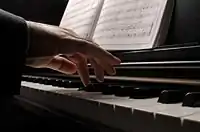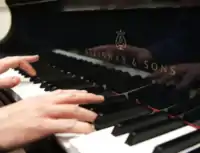
How to read piano music

Piano music generally contains two staves: the treble staff and the bass staff. Notes higher than middle C are usually placed on the treble staff while notes lower than middle C are usually placed on the bass staff.
The treble clef may also be called the G clef. The line that passes through the centre of the swirling part of the Treble Clef is the G line. The G just above Middle C sits on this line. The bass clef may also be called the F clef. The line that passes through the two dots of the Bass Clef is the F line. The F just below Middle C sits on this line.
Music notes are either placed in spaces or on lines. Moving from a line note to the very next space note in piano music is the same as moving from one white key to the very next white key on the piano. Moving from one note to the next is called a step. The best approach to figuring out note names is by counting steps after having learned the main landmarks: Middle C, G line, F line, Treble C, and Bass C.
According to Wictionary, Treble C and Bass C are one octave above and below middle C, which would find them on space 3 of the treble staff, and space 2 (from the bottom) on the bass staff.
How to play major scales
C Major

The following are some basic scales to learn for the keyboard. The basic C Major scale is shown to the right as a baseline reference. The letters represent notes of the scale, while numbers represent the suggested fingering for each scale.
You can use the following fingering for the notes for the right hand:
C D E F G A B C 1 2 3 1 2 3 4 5
Notice that the thumb goes under the middle finger as the scale progresses from E to F.
For the left hand, you can do
C D E F G A B C 5 4 3 2 1 3 2 1
Notice that the middle finger is tucked over the thumb as the scale progresses from G to A.
D Major
Right hand fingering
D E F# G A B C# D 1 2 3 1 2 3 4 5
Left hand fingering
D E F# G A B C# D 5 4 3 2 1 3 2 1
- 1 represents the thumb.
- 2 the index finger.
- 3 the middle finger.
- 4 the ring finger.
- 5 the little finger (pinky).
Case studies
Here are suggestions for piano studies (listed roughly by difficulty) To participate in these case studies, one should have the music readily available (most of them can be easily found at IMSLP).
- Hanon: The Virtuoso Pianist in 60 Exercises
- Short pieces from The Notebook for Anna Magdalena Bach by Johann Sebastian Bach
- Nineteenth-Century Pedagogical Character Pieces such as those of Cornelius Gurlitt or Friedrich Burgmuller
- School of Velocity and Other Studies by Carl Czerny.
- Mikrokosmos of Bela Bartok
- Tewntieth-Century Character pieces such as those of Dimitri Kabalevsky, Alexander Gretchaninoff or Samuel Maykapar
- Two- and Three-Part Inventions of Johann Sebastian Bach
- Multi-movement sonatinas such as those of Muzio Clementi
- More difficult Nineteenth-Century Character Pieces such as those of Robert Schumann, Edvard Grieg or Felix Mendelssohn
- More Complex Sonata forms such as those of Franz Josef Haydn or Wolfgang Amadeus Mozart
- Nocturnes of Frederic Chopin
- "Pictures at an Exhibition" by Mussorgsky
- Preludes and Fugues of Johann Sebastian Bach's Well-Tempered Clavier
- Sonatas of Ludwig van Beethoven
- Etudes by Frederic Chopin
- Etudes-Tableaux by Sergei Rachmaninoff
- Douze Études d'exécution transcendante by Franz Liszt
- Other works by Liszt, Rachmaninoff and Chopin
Beginner pianists should not be daunted by the size of the list, especially its latter half; working through these studies should take months if not years of devoted practice. Take note that the above list consists only of suggestions, and are not "mandatory for any and all pianists." However, in the process of studying a piece, a pianist ought not to put emphasis on snapping up the piece as quickly as possible; rather, he should take time ensure that the technique is being properly developed. It is difficult to correct technical errors once they have been practiced solidly into a piece.
Technique

To achieve a perfect technique and total virtuoso piano playing, one must consider several critical factors, these must be reviewed and taken into account at all times.
- One of the most important is to have a position of the hands as relaxed as possible, without any unnecessary tension at the wrists and the rest of the hand.
- Another factor to be taken into account is that when we play there must be a connection between the fingers, just at the time one of the fingers rises, the other lowers. In other words: there should never be a silence (no matter how minimal) between the two notes, nor should the notes sound simultaneously (even in a lapse of microseconds).
- Another factor that is important is the position of the hands, which should always be light and playing with the pads of the fingers (not fingertips).
- Another point that should be taken into account is that the speed of your fingers has to be equal. Normally, there are many mediocre pianists whose fingers 2 and 3 have much more strength and speed than those 4 and 5. This must be avoided. At this particular point, Hanon helps a lot, enlisted in the works above.
See also
This page was requested at Wikiversity:Requests
You may want to get involved at Basic Blues & Rock or Jazz if you are interested in playing piano, organ or keyboards within those Music genres.
External links
- Mutopia, an online resource for free sheet music
- IMSLP, International Music Score Library Project, a resource containing many music scores, including some of the ones recommended in the article
- Fundamentals of Piano Practice, online textbook teaching the most efficient way to practice piano playing
- Useful links for "Wedding-day at Troldhaugen" by Edvard Grieg.
- Piano lessons in London, List of piano teachers in London and the UK
- Pianist, composer, and piano teacher in London, private piano teacher based in central London
- Listen to some classical piano recordings from a pianist in London